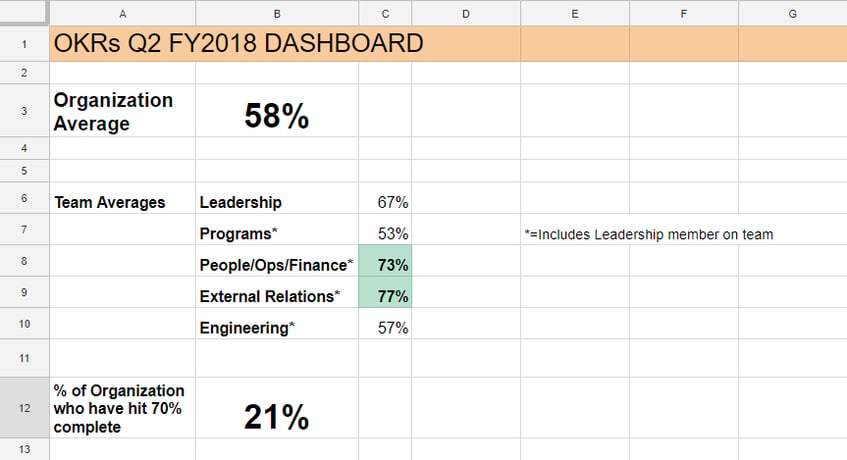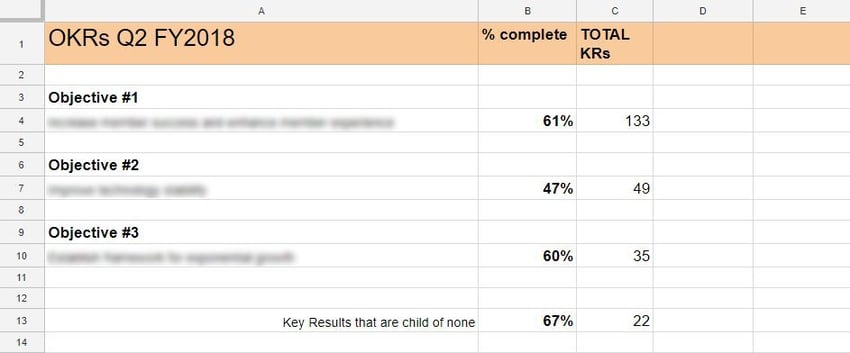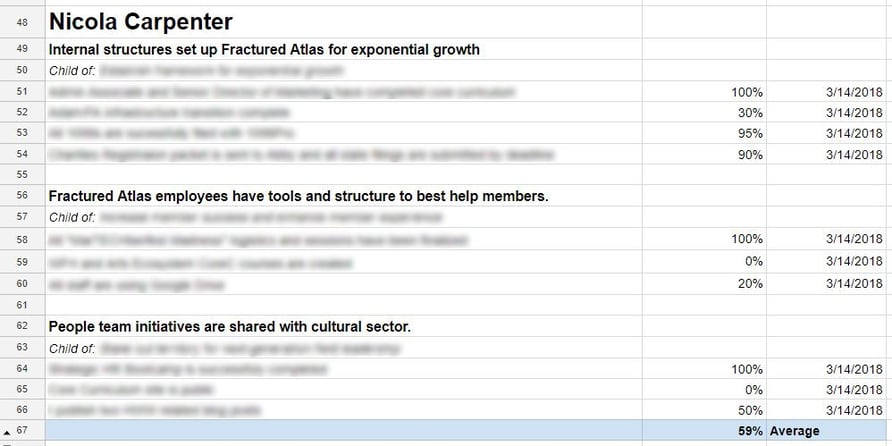A Guide for Creating Organizational Alignment & Accountability
Big Ideas | How We Work | Okr | People Operations | Human Resources
Earlier this year I wrote a post explaining why I think Objectives and Key Results (OKRs) are great ways to track goals. As a quick refresher, OKRs allow teams and organizations to align goals for a set period of time in a transparent and connected way. Since then, I’ve gotten questions about the logistics of implementing the OKR framework in an organization and the process that Fractured Atlas uses. I decided to compile this information into a toolkit that you can use and iterate on. I hope that it helps in your process of deciding whether to use them in your organization and how to implement them.
If you’re not sure why you would use Objectives and Key Results, you might want to read the post mentioned above before diving in. Also, organizations vary widely, so instead of viewing this as a prescription for what to do, figure out what inspires you and works for your organization. Go ahead and try some of the things we’ve done and see how they work (more below on how many iterations it took to get to where we are now…and we’re still iterating!)
Bonus: There’s a free goal tracking template waiting for you mid-way through this post.
Our Current OKR Process
Timing

Timeframe
OKRs are generally set quarterly, and Fractured Atlas uses this same time frame. The quarters align with our Fiscal Year starting in September. The three-month window is enough time to get some sizable things done, but short enough to reset if something is completely off track. Another benefit to having shorter time frames (compared to something like an annual plan) is that people can get the benefits and excitement from smaller wins throughout the year (instead of working on a project and not feeling accomplishment until the end of the year).

Timeline to Set OKRs
We have found that it works for our organization to wait until a quarter ends before setting the next quarter’s OKRs, otherwise we were setting the next round of goals before we had delivered the previous round of them. We also make sure that everyone’s OKRs are finalized by the 15th of the month.
We start with the Leadership Team setting two to four Organizational Objectives, which then cascade to each member of the Leadership Team, their reports, and further reports (reminder that this cascading from Organizational Objectives helps each employee see how their work impacts the organization and helps align everyone’s goals). With the current tiers of cascading objectives, finishing by the 15th of the month generally gives each group three to four days to draft and finalize their individual OKRs.
To get an idea for what our schedule looks like, here is the timeline we used to create our Q3 OKRs from this current Fiscal Year:
- Wednesday, February 28–Friday, March 2: Leadership Team drafts the Organizational Objectives for the quarter along with their individual OKRs.
- Monday, March 5th: Leadership Team have final Organizational Objectives and their own OKRs in the shared company document.
- Wednesday, March 7: Leadership Team’s direct reports have draft OKRs in the document and talk with their supervisors.
- Friday, March 9th: Leadership Team’s direct reports have final OKRs in the document
- Tuesday, March 13th: Further Reports have draft OKRs in document and talk with their supervisors
- Thursday, March 15: All Q3 OKRs are finalized.
What Tools We Use
We currently track our OKRs in a Google sheet shared in an Institution Team Drive (we have GSuite for nonprofits, so this is a convenient way for us to share and track our OKRs organization wide). Here is a look at what our Q2 sheet contains:

When a staff member opens the document, they’ll see a dashboard like the one above. Throughout the quarter this page automatically updates to represent the current total percents based on each person’s completed percents.

When we started creating organizational objectives, we added a tab for them to live. As mentioned earlier, these are set by the Leadership Team and are overarching goals that the organization will focus on in the quarter. They can include things like focusing on engineering and product development, efforts to better serve our members, and identifying opportunities for growth.
We also started tracking the total Key Results that map to each objective, and the percent complete (based on each Key Result, not based on people). This is pushing the functionality of Google Sheets and is largely a manual process. We might decide to change this in the future, but for now it is great to see how staff Key Results map to the organization’s accomplishments.
This lets people see how their own work directly impacts the objectives of the organization.
Note: This image was from the first quarter we tracked individual Key Results to Organization Objectives, and there were a fair amount of Key Results that were “child of none” that did not map to an organization objective. In the subsequent quarter, we tweaked how organization objectives are worded and communicated, which resulted in every Q3 Key Result mapping to an Organization Objective.

Each person at Fractured Atlas drafts their own OKRs. The photo above is an example of what this looks like for an employee (in this case me). When people draft their OKRs, each of their objectives are children of either their manager’s objectives or organizational objectives. In the photo above, you’d see these parent objectives right after Child of. Each person then has a conversation with their manager and team to make sure their goals are in alignment. After confirming the OKRs, the employee then tracks the completion percent throughout the quarter. Additionally, there are periodic check-ins between the employee and manager that allow for conversations and agreements around what’s important, what people need to do their work, and what challenges they’re facing. This makes OKRs a powerful management and professional development tool.
If you want to delve deeper into what our file looks like, we have a public template linked below.
On-boarding and OKRs
There are a fair number of interlocking pieces that come together to create our OKR process at Fractured Atlas. This means that there is a learning curve in bringing new people in to the process. However, it’s also a great way for new staff to see the organizational and individual priorities right when they start. We also keep all past OKR files, so new employees can flip through past OKR documents to see how we got to where we are.
During Core Curriculum, new employees watch this video and then are asked to draft an objective and a few key results for their first few weeks of training. This gives people practice drafting OKRs right away. Then, depending on someone’s start date, they will generally join in on OKR creation the following quarter.
A Template For You
We’ve made a template that you can copy to make your own, found HERE.
How We Got to Our Current Process
The Beta (or Pilot) Phase
Two of our Core Behavioral Values at Fractured Atlas are “Seek Continuous Improvement” and “Make It Happen.” We like to try out new things, but also want to recognize that not all new things are an improvement. How do we experiment without committing the entire organization to a process or tool? We have things go through a pilot phase.
This is how our OKR pilot phase looked at Fractured Atlas:
- December 2015–February 2016: Leadership Team experiments using OKRs within their group. The OKR specifics are transparent to the group, but not the full staff.
- March 2016–May 2016: In addition to the Leadership Team, two additional teams were added to the OKR process. In adding these two teams, we were able to test the increased complexity of setting and cascading OKRs throughout different functional teams.
- June 2016–August 2016: All remaining teams at Fractured Atlas were added to the process. At this point, we still considered it to be the pilot phase, but with increased certainty that we would continue experimenting beyond the current quarter.
- End of 2016: Fractured Atlas began using OKRs as a fully-formed tool.
Iteration
There has rarely been a quarter when something in the OKR process hasn’t changed. Sometimes those changes are small, sometimes they’re a bit more substantial. Each change brings us a little closer to finding an OKR process that works best for Fractured Atlas right now. This is just a short list of things that have changed over the past two years:
- We switched from yes/no binary completion to % complete. The yes/no was a simpler way to track earlier on, but didn’t allow for things that were mostly done. When getting a project to 90% completion and then receiving 0% — even if the project shipped early the next quarter — was frustrating. We needed a way to reflect the work that was done, especially when it exceeded where we thought we would be.
- We added and then eliminated columns for “How the KR will be assessed” and “Where the data is coming from.” While in the beginning these helped people to think about finding measurable Key Results, they started becoming too complex and distracted from the Key Results.
- One team tried using 7Geese. We found it to be more comprehensive than what our needs were at the time.
- We tried out adding a “confidence goal will be met” column, and then decided it was more information than we needed.
- We added the dashboard to see the organization and team averages at a glance.
- We introduced Organization Objectives with the restructuring of our management team.
Reading & Research
Before planning out OKR implementation, we did a whole lot of research. We still read what’s out there to iterate and improve our current process. These are just some of the sources we found:
- 7Geese Resource Library (be sure to check out their printable guides)
- How Google sets goals: OKRs (video) If you’re skeptical that OKRs won’t work for your organization because you’re larger than Fractured Atlas, this video gives a look into how Google implements and thinks about them (and they have over 70,000 employees.)
- Google Re:Work Goal Setting Guide
- Radical Focus: Achieving Your Most Important Goals with Objectives and Key Results
- Perdoo Crash Course in OKRs This gives a great history of the origins of OKRs.
Have you tried using OKRs? What worked or didn’t work for you? We’d love to hear from you!
About Nico Carpenter
Nico Carpenter (they/he) works on the People team at Fractured Atlas, where they find ways for tools and processes to better align with the organization’s purpose. Prior to joining Fractured Atlas, Nico worked for a variety of arts organizations including MoMA PS1, Walker Art Center, and Heidelberger Kunstverein, and he still has a particular love (and skepticism) for museums. They also serve on the board of Fireweed Community Woodshop. Originally from Minneapolis, they received a BFA in Art from the University of Minnesota and continues to stay creative through knitting and sewing clothes. He is currently in too many book clubs, but still finds time to read books about organizational culture for fun.


